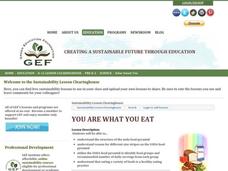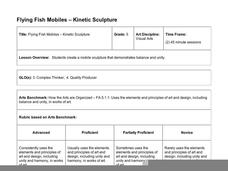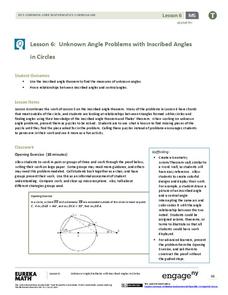Curated OER
Information Overload: Looking at News
How do events reported in mainstream newspapers, on television news, blog posts, and social network sites differ? Ask your class to investigate the way the same news item is presented in the many information sources available. Groups...
Curated OER
Teach Ancient Greece!
“We alone regard a man who takes no interest in public affairs, not as a harmless but as a useless character.” Pericles’ comment, part of a funeral speech, sets the tone for a unit study of Ancient Greece. A series of activities...
Curated OER
Israel & Palestine: The Fight for Peace
Young researchers explore the history of the peace process in the Middle East. They write a paper about the Israeli-Palestinian conflict and view the video Israel and Palestine: The Fight for Peace. They discuss the events leading up to...
Curated OER
Monoprint Screams on Clay
Using a famous painting as a model, have your class create their own works of art. Learners take a look at the painting "The Scream" by Edvard Munch, discuss their thoughts on it, and use a similar process to design their own art. What a...
Curated OER
You Are What You Eat
Students identify healthy food choices from the food groups on the USDA food pyramid. In this nutrition and health lesson plan, students identify and name examples of each food group displayed on the food pyramid. Students cut out...
Curated OER
Lesson Plan 18: Art Project! Design Your Own Book Cover
Finished your novel? What’s next? Designing the book cover, of course. But how to begin? After examining the covers of published books and noting the common elements of these jackets, young novelists design a front and back cover for...
Hawaiʻi State Department of Education
Flying Fish Mobiles – Kinetic Sculpture
Budding artists experiment with balance and movement as they learn about Alex Calder and his kinetic sculptures. They'll view several of Calder's pieces and review biographical information, then they'll work through the artistic process...
EngageNY
Why Move Things Around?
Explore rigid motion transformations using transparency paper. Learners examine a series of figures and describe the transformations used to create the series. They then use transparency paper to verify their conclusions.
EngageNY
Chance Experiments with Equally Likely Outcomes
Take a deeper dive into equally likely probabilities. Pupils build upon their understanding of probability by determining sample spaces and outcomes. Individuals work with sample spaces and determine outcomes that are equally likely....
EngageNY
Understanding Variability When Estimating a Population Proportion
Estimate the proportion in a population using sampling. The 20th installment in a series of 25 introduces how to determine proportions of categorical data within a population. Groups take random samples from a bag of cubes to determine...
EngageNY
The Relationship of Multiplication and Division
Take any number, multiply it by five, and then divide by five. Did you end up with the original number? In the same vein as the previous lesson, pupils discover the relationship between multiplication and division. They develop the...
Daughters of the American Revolution
Lesson 1: How Do Society’s Expectations Influence Education?
The history of women's education can be traced back to the delicate stitching of student samplers from the 19th century. Modern-day pupils examine and analyze four primary sources, three of which are images of embroidered samplers, which...
Curated OER
All the News That's Fit to Click: Analyzing New York Times Design
Explore the New York Times, online and in print. Partners take the roles of reader and monitor while each peruses the newspaper. Discussion questions compare the online version to a hard copy print edition. Links provide comparison of...
Curated OER
Name That Leaf
Take a walk through nature with a science experiment about leaves. Third graders use a branching diagram to group attributes of certain kinds of leaves, such as oak, pine, and chestnut. For extra practice, they can collect leaves and...
Curated OER
Verb Tenses
Why is it so important to have consistent verb tense when writing? Discuss some of the implications with your middle and high school classes. Examples are provided, and both incorrect and corrected sentences are shown. There's a lot of...
Humanities Texas
Primary Source Worksheet: “Report on Manufacturers,” Annals of Congress
Invite your learners to take a look at life during the term of United States president George Washington through analysis of an interesting primary source. The document summarizes American manufacturing capacities, as detailed by the...
iCivics
Represent Me!
Your class members will take on the roles of legislators and work to serve their constituents in a fun online video game. They will practice sorting and approving bills based on the wants of the people they represent, and understand the...
ESL Kid Stuff
Wheels on the Bus
Take a trip all around the town! Kids go round and round with a fun set of lessons based on "The Wheels on the Bus." After singing the song together, little learners figure out the hand gestures, reenact the song, and read an...
Council for the Curriculum, Examinations and Assessment
Safety and Managing Risk
Teenagers love to take risks to test their personal boundaries, but many risks are too dangerous to try. The set of exercises in this packet teach your class about the ways they can stay safe and protect themselves while still having fun.
EngageNY
Unknown Angle Problems with Inscribed Angles in Circles
We know theorems about circles—now what? Class members prove a theorem, with half the class taking the case where a point is inside the circle and half the class taking the case where a point is outside the circle. The lesson then...
Ontario
Computer Hardware —Computer Studies
What kind of components are needed for a computer? Through a differentiated lesson plan, individuals learn about six hardware computer components. They conduct research to determine the range of options for the components. Class members...
Royal Society of Chemistry
Mass Changes in Chemical Reactions—Microscale Chemistry
What better way is there to introduce conservation of mass than a few simple experiments? Young chemists conduct two chemical reactions, take the masses of reactants and products, then compare their results to determine differences in...
Curated OER
True Spin: Music
Upper graders take a critical look at art criticism, music, and politics. They watch one segment of "True Spin," produced by VH1 music television and then discuss myths that relate to art and music. Several modern songs are analyzed...
Curated OER
Cartography Project
A instructional activity involving mapping, the use of a compass, writing and following directions, and exploring the first two themes of geography is here for you. Learners create original maps that show the routes they take through...

























